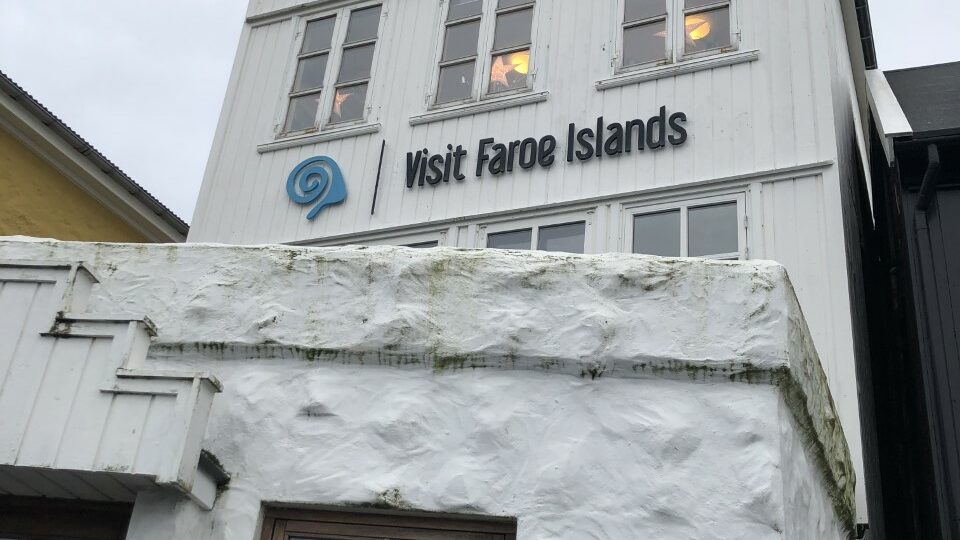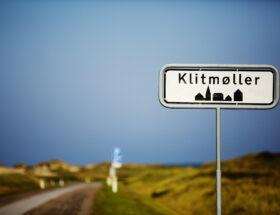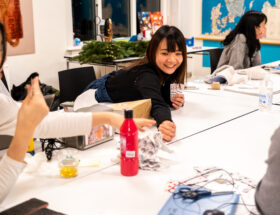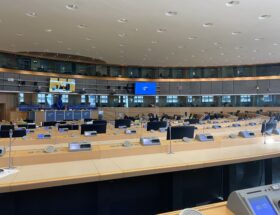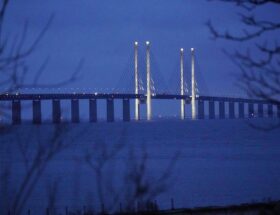Visit Faroe Islands works with marketing and sustainable development of the Faroe Islands as a destination // CREDIT: Fredrik Holtekjølen
Corona has suffocated the tourist industry all over the world for the past two years, but for some the suffering is greater. The Faroese Islands, tourism stands for a third of the nation’s income, and has been hit hard by the travelling restrictions. But on the horizon is a new way of doing tourism: namely green.
By: Fredrik Holtekjølen
Yesterday’s stormy weather seems like a fever dream now that the morning is calm here in Tórshavn: the capital of the Faroe Islands. But now and then a breeze sweeps through the landscape and carries a certain scent of ocean that bears witness of the whims of the sea that reigns here in the North-Atlantic.
The sun has just started to peak up from behind the snow-covered mountain but has not been able to chase the bluish tint on the run that veils this raw and naked landscape – yet, anyways. For the Faroese people, the workday has just begun, as more and more cars drive through the main street. The birds too have started their day as they circle over a fishing boat that has just docked in Fiskatorgið í Vágsbotni – maybe hoping to catch a slice of the night’s catch.
And as the day becomes brighter a van pulls up and a man comes out and introduce himself as Samson Højgaard. He is a tour guide for the only company who does excursions during wintertime. The island does not get a lot of tourism during this time of the year, the tour guide admits, but the decline of tourists has stretched into the summer months, solely because of covid-19.
“So, it’s lovely to be your guide for today”, he says.
In the van there is also a man and a lady from Italy. The couple says that they specifically chose to go to the Faroe Islands because it seemed like the perfect place to escape corona.
“Less people mean a smaller chance to get infected”, the woman says.
All bookings got cancelled
Yet there is over 600 cases and 10 people hospitalized in The Faroe Islands, quite a high number considering there are just over 53.000 inhabitants living here.

But the Italian lady says she is talking about the fact that you can keep socially distanced and besides, it would also be less people touring the country, meaning bringing less infection through the border.
“But I was quite surprised that nobody wears masks here, in Italy it is mandatory”, she points out.
To that the tour guide adds that one can socially distance here because there are few people and a lot of space. Despite that, we are all crammed inside this minivan without any masks.
Samson Højgaard, the tour guide, continues and says he has especially been hit hard by the travelling restrictions concerning covid-19. He in fact founded a boat touring company in the late summer of 2018 – and fast forward to 2020, he lost all his clients.
“When corona came every booking, I had got cancelled, that was really sad”.
Luckily for Højgaard he was able to receive economic compensation by the government and has kept his company afloat.
From day to night
Another actor in the tourism field is Friðun Jacobsen, she is the owner of the travelling agency Greengate. They offer tours in the Faroe Islands.
She says that when corona entered the scene it was like the world shifted from day to night:
“Suddenly we had no tourists, but this didn’t just affect us in The Faroe Islands, but all over the world”.
As with Højgaard, Greengate did also receive economic compensation for lost income. This helped Jacobsen to keep her employees without having to lay them off during the hardest times.

“We received financial aid to pay off fixed expenses like electricity and insurance”.
But the decline in tourists resulted in less working hours and thus reduced salaries.
“It has been hard keeping the wheels turning without any income”, Jacobsen adds.
She tells how fellow colleagues in other parts of the industry have had to leave the industry and find work elsewhere. But there is one actor in the industry who has been able to keep afloat she points out:
“Hotels were able to just redirect and cater to locals instead”.
Tourism has played a big part in the development of the capital for locals, Jacobsen says. She remembers when she was younger, there were less cafés, less shops, less restaurants and less hotels in the city. Now, because of the increased tourism, Tórshavn has become rather urban, she thinks. How metropolitan a city of 22.000 people can be, is debatable.
“The city has grown tremendously because of tourism, and besides, now we as locals can also use the facilities. Therefore, it is important for me that Faroese people is seeing the benefit of having more tourism here. We need to have the locals onboard in order to further develop this country”.
A green shift within the tourism
Corona has made life harder for the tourism in the Faroe Islands. In 2018 the Faroe Islands had around 150.000 overnight stays, according to Statistics Faroe Islands. In 2020 it was more than halved.
For Jacobsen this situation has offered her time to think and reflect.
“It was sort of a wake-up call with covid. Before the virus everything was going fast paste, everything drove in fifth gear. However, now we got the time to think and reconsider how we did things”.
With the extra time to think Jacobsen has concluded that sustainability and the climate are two keywords for the future. One way of doing that, she suggests, is to engage tourists in activities that benefits the local communities.
“It can be to build a new walking path or making a fence – everything counts”.
Hit hard
Susanna Sørensen is working at Visit Faroe Islands. She says that the islands have been hit hard by travelling restrictions. As for many other countries.
“The Faroe Islands were closed in March 2020, which was opened to visitors in the middle of last summer, so some foreign guests came, but otherwise it was closed”.

The solution was to cater to locals, but Sørensen admits that it is harder to cater to a country with only 53.000 inhabitants:
“There are not that many Faroese, so even though they definitely used the opportunities that are in the Faroe Islands, there are not that many people here, so we are not able to replace foreign guests”, she says.
The extra time without foreign tourists in the country, Sørensen and Visit Faroe Islands, spent thinking about their new strategy.
“We have chosen to use the time to discuss future strategy for the Faroe Islands and how we ensure that tourism can be good for the Faroe Islands and all of us who live here. Like other places, there are people in the Faroe Islands, perhaps especially in some of the small places, who are not so fond of tourists. We want to communicate with everyone, even those who are skeptical, to try to find solutions that most people can agree on. The pandemic has given us the opportunity to discuss and think about what tourism we want in the Faroe Islands”.
Interfere with animal life
Jacobsen at Greengate who sells the unspoiled nature of the Faroese island, says sustainability ties closely with the protection of the nature here.
“We must be careful of our nature and the animals that lives within it. Especially the bird life”.
The bond between the animal kingdom has always been prominent on the island. Sheep outnumbers the human population by the double and more than 300 species of birds frequents the island. The Atlantic puffin being the most famous one with its colourful beak. Now the puffin face danger, the European population has halved in the past 65 years and is now on the brink of extinction.

Mykines, the western part of the Faroe Islands, is a bird paradise for the Atlantic puffin. In recent years has the island seen an increase in tourism. This has led two researchers from the University of Roskilde to see which impact the tourism has on the nature and wildlife.
They conclude that:
“The islands have a lot of potential as tourist attraction. The country has a unique nature, which stands in contrast to large parts of the world – this has meant that tourism has increased significantly in a very short time. Therefore must regulated to control and preserve the Faroe Islands as the travel destination it is today”.
This has also led the Faroese tourist council to think “green” Jacobsen in Greengate says, when it comes to future tourism.
“Our land isn’t built for a lot of tourism, and we must make sure that the tourists we get are not leaving a big climate footprint”.
Nature is at stake
In Svalbard, an island north of Norway – the authorities warn how tourism has a negative effect on the nature and wildlife there. In 2019 alone, over 150.000 people came to visit. That is around the same amount that visited the Faroe Islands. Some of the findings is that where cruise tourists go ashore, the vegetation is worn out, cultural monuments are affected by erosion, as a result of, among other things, increased tourist activity. The infrastructure is overloaded during visits. Snowmobile traffic disrupts wildlife, such as mountain foxes and polar bears.
This too is what can be at stake for the future of the Faroe Islands. Faroese tourism is growing, and although corona has led to stricter travelling restrictions there are no holding back for the island who sells itself as: “unspoiled”. However, the pandemic has shown that the future for the island must be green and in tune with nature and wildlife.

